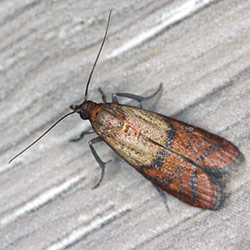Identification
- Colour Pale gray and reddish brown
- Size 16 to 20mm wingspan with 6 to 7mm body length.
- Description Adult Indian meal moths have a distinct two-colour wing pattern with a yellowish white base and reddish brown upper area. Indian meal moth larvae are wingless, caterpillar bodies. They are a pale white colour, possibly with shades of pink or green depending on diet.

What attracts Indian meal moths
In Canada and around the world, people find Indian meal moths lurking in stored food. Stores, warehouses, and granaries may house the pests, or they can find their way into homes inside processed foods or by flying in from the outdoors. These moths will infest dry snacks, seeds, grains, or starches.
The dry items that these moths infest double as food sources. Common stored food products, that Indian meal moths infest, include grains, chocolate, dried fruit and beans, herbs, seeds, and spices.
Indian meal moths Habitat, Diet, Lifecycle
Indian meal moths and other similar meal moth species earn the name pantry moths because of their egg-laying habits and larvae that feed on pantry foods. While most people notice them in their adult form, it is actually the larval stage that causes the most problems.
Habitat
In Canada and around the world, people find Indian meal moths lurking in stored food. Stores, warehouses, and granaries may house the pests, or they can find their way into homes inside processed goods or by flying in from the outdoors. These moths will infest dry snacks, seeds, grains, or starches.
Diet
The dry items that these moths infest double as food sources. Common stored goods that Indian meal moths eat include grains, chocolate, dried fruit and beans, herbs, seeds, and spices. In addition, Indian meal moths consume starches like adhesives pastes used for furniture or wood.
Life Cycle/Reproduction
After mating, female Indian meal moths lay hundreds of sticky eggs directly onto a food source. Once hatched, larvae form vast webs of silk. At the pupal stage, they create silken cocoons, pupate and then finally emerge as adults.
How worried should I be about Indian meal moths
Larvae attack and feed on the product that they infest, making it inedible. The silk webbing they create gathers frass and shed skins, causing more contamination. The Indian meal moth can have 5-6 generations in a year, making quick detection key.
Seeing adult Indian meal moths can indicate that there is an infestation nearby, and requires regular inspections of any stored foods. Silky cocoons or webs in product are the strongest indication of their presence, though these visual signs may not always appear. Seeing late stage (mature) larvae wandering around on surfaces, often near infested product is also a clear indication of an infestation.
How can I prevent Indian meal moths invading
To help prevent an Indian meal moth infestation, always inspect any store-bought foods or cooking products. Sanitation is critical when dealing with Indian meal moths. Regularly clean out cupboards and containers using soap and hot water. Homeowners can also store items in containers with airtight locks, avoiding any holes, openings, or loose flaps.
Other pests related to Indian Meal Moths
100% Satisfaction or Money Back Guarantee
Resolving your pest problem is our #1 priority. If re-treatment is required, we'll provide immediate services at no extra cost. If your expectations are not met, we guarantee a full refund of your service payment.
Remove pests from your home, and stop them from coming back
We work hard to listen, understand and assess your unique situation. Request a free, no-obligation estimate today for a customized pest program that fits your needs.
Request a Free Home EstimateRequest a Free Business Consultation

